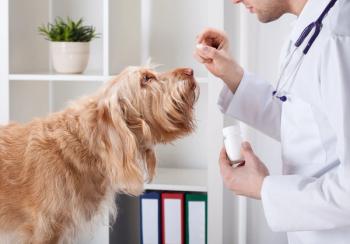
Pet health insurance: What we're learning from ObamaCare
Veterinarians-not insurance companies-may be in charge now and in the future when it comes to pet insurance.
If I were to raise hell at a "town hall debate" over health insurance, it wouldn't be about rationing, the public option or the plight of the uninsured. I would complain about the failure (almost conspiratorial, I think) of either side of the reform debate — the politicians, the media, the pundits — to explain in understandable language what the draft legislation actually would do and how each proposal would work.
Christopher J. Allen DVM, JD
We all know perfectly well that no one is going to kill Grandma, and we all know that the current system of health insurance, underwritten at last resort by taxes, is unsustainable. But why won't anyone summarize clearly what the proposed House and Senate bills contain and what the various programs will cost?
Motivated by frustration with the human health-insurance debate and a belief that pet insurance is a critical concern for our profession, I want to explain the fundamentals of pet health insurance as it is available today. And I want to do so succinctly.
We're in the driver's seat: Veterinarians-not insurance companies-may be in charge now and in the future when it comes to pet insurance.
Personally, I am a convert. I have disliked the insurance industry ever since I was an insurance attorney in the early 1980s. Insurance is the house's game. It is a poor investment in almost every case. Nonetheless, it is a vital and indispensible risk-management tool, without which modern business — and health care — would grind to a screeching halt.
So why am I a convert on pet health insurance? Why do I now believe wholeheartedly in a concept that made me chuckle during my first 20 years in veterinary practice whenever a client would ask about a pet policy?
I believe in pet health insurance now for two simple reasons:
First, insurance has improved.
Second, I am tired of telling my clients that they can't afford what my colleagues and I can do for them.
How pet insurance differs from human-health policies
There are a lot of differences between human health coverage and what is out there for pets, but one difference that really jumps out at me is one that few of us consider. For humans, the government and insurance industry are in the driver's seat, but in the pet health insurance world, you and I run the show.
It's true. We DVMs will make or break this business, and here's why: Not many employers are going to offer pet insurance as a workplace benefit (except vets, maybe). No college is going to require pet coverage before your kid is allowed to enroll. I haven't run across anybody yet who lies awake at night because he doesn't have a quality major medical policy for his dog or cat. Who makes the market in this product? We do — private veterinarians, specifically general practitioners.
This is a tough pill for the pet-insurance industry to swallow. It would make for a pretty sad business-school case study where a product's only genuine sales force: 1) doesn't know much about the product, 2) has another demanding full-time job, 3) hates to sell things, and 4) is prohibited legally and morally from accepting lavish gifts and premium-splitting schemes.
So what are salespeople in a niche insurance market to do? They are forced to default to Plan "B" — encouraging us to recommend their product because it is in the best interest of our clients and ourselves to get more pets insured. And this is, in my opinion, exactly what is happening.
Another key difference between the human health-care model and that for pets is the availability of a "health- care financier of last resort."
Currently, a person's sudden, catastrophic medical problem will be handled fairly quickly, and there will be somebody to pay for the care. For example, if an uninsured, indigent 70-year-old suddenly discovers he can't urinate, he can go to an emergency room and receive immediate catheterization and aftercare. If he cannot pay, the hospital eats some of the cost and the government eats the rest.
Pets have no last-resort payer unless the hapless cat or dog owner whose pet is in the same boat as our human example stumbles upon a vet generous enough to do the catheterization at midnight for free.
The similarities
The two biggest similarities I see between the human medicine world and the veterinary world are these:
- First, the technology, innovation and availability of diagnostic and therapeutic modalities (the things we doctors offer) is expanding at breakneck speed.
- Second, everybody wants access to all the great new stuff, but those innovations are becoming so expensive it is unrealistic to expect the average person to be able to subsidize that level of care out of pocket.
But since we cannot finance pet-cancer therapy any more realistically than we can put Grandma to sleep, we as a profession must look to third-party financing to permit us to do what we are capable of doing for our patients.
And it wouldn't kill any of us to start being able to charge something approaching what our skill is worth, either.
Keys to pet health insurance
Assume for a moment that I am correct in my assertion that the primary-care veterinarian is the person most likely to convince a pet owner that insurance is a wise decision. (Some would say that a receptionist or office manager can accomplish this, but the jury is way, way out on that point.) If we doctors believe in a product, our sincerity and our credibility will carry the day. These qualities will help us avoid the hard sell and the need to spend a lot of time convincing clients.
However, you can't be sincere in your support of a product unless you have one or two favorites and have learned enough about the pet insurance companies and their policies to make an informed recommendation. To assist in that regard, I will lay out the qualities I believe are most important to veterinarians and clients to consider.
Remember, insurance is not an investment. It is a tool to manage risk. Clients deserve — and you should endorse — a tool that, very simply, works well for the money.
And a caveat: If I were you, I would check first and foremost into how quickly and effectively clients get reimbursed. Good coverage is not worth much if it is awkward and full of hassles when it is used.
Coverage issue No. 1: The percentage
Each pet-insurance program generally agrees to cover a certain percentage of the "veterinary bill" (definition of which may vary; see below) for covered accidents and/or illnesses. I think coverage percentage is important because, when the surgeon says the procedure will cost $2,000, clients may be able to come up with $200, but not $400.
Coverage issue No. 2: What is excluded?
Clients are no different from us. They don't want smoke-and-mirrors or bait-and-switch. Most pet-health policies exclude many or all pre-existing conditions, as do many human policies.
Pet health-insurance companies also are likely to limit or exclude hip dysplasia coverage while occasionally a company will offer hip dysplasia coverage at extra cost. Some companies do not cover any congenital or hereditary disorders.
The best approach is to contact the major insurers and compare exclusions. Generally, the fewer restrictions, the better.
Coverage issue No. 3: What is a veterinary bill?
Human HMOs have a list of care providers. Medicare tells MDs what they can charge if they expect the government to pay. The pet health-insurance version of this phenomenon is the definition of "covered veterinary fees."
The long and the short of it is that, when the company says it will pay a percentage of the fee, the fee that really counts to the client is the actual fee charged by you or the specialist to whom you refer.
I suggest that before you recommend policies that have an insurer-established schedule of how much a certain procedure (such as a catheterization) should cost, you should make sure the schedule is realistic.
It's one thing to decide to set your fees based in part on insurance reimbursement. It's quite another to send a client to a terrific specialist on referral only to find that his fees are, effectively, only 50 or 60 percent reimbursable.
Two things to note: First, all the companies have a maximum payment for any given policy, like human insurance. Second, most pet-insurance policies have a per-claim deductible.
Coverage issue No. 4: Premiums rise with pet age
Each of the plans I looked at had different pricing systems for aging pets. The difference can be analogized, I suppose, to the difference between term insurance and whole life.
Trend can't be ignored
I have to believe that if we want to be able to practice our profession to the best of our abilities and offer all that we can, we must get out in front of the problem.
Wages are not going to increase as quickly as our invoices. Consequently, we must embrace third-party payment. We need to be proactive in our patients' health-care insurance, or our voices will be drowned out.
Dr. Allen is president of the Associates in Veterinary Law P.C., which provides legal and consulting services to veterinarians. Call (607) 754-1510 or e-mail
Newsletter
From exam room tips to practice management insights, get trusted veterinary news delivered straight to your inbox—subscribe to dvm360.




